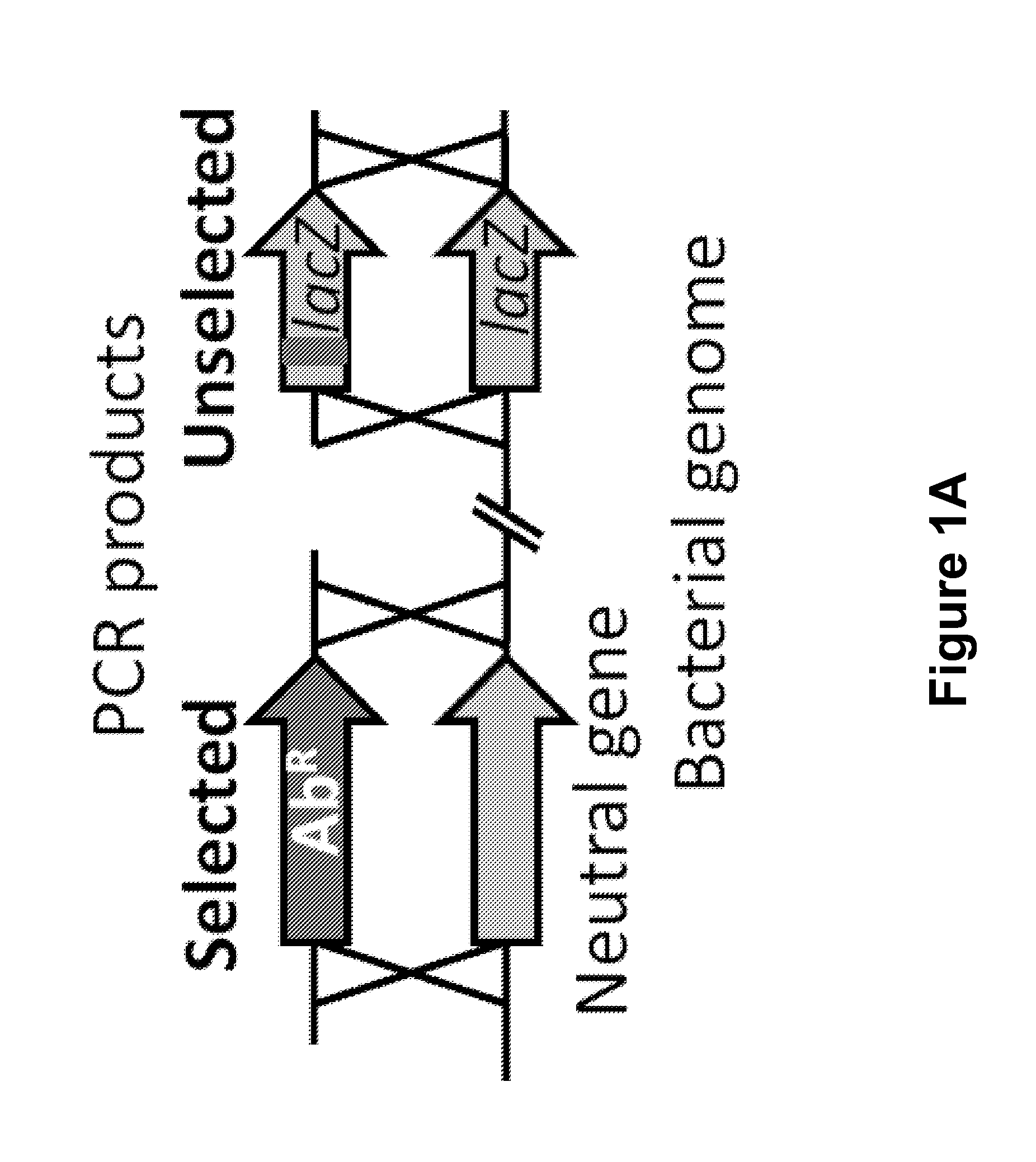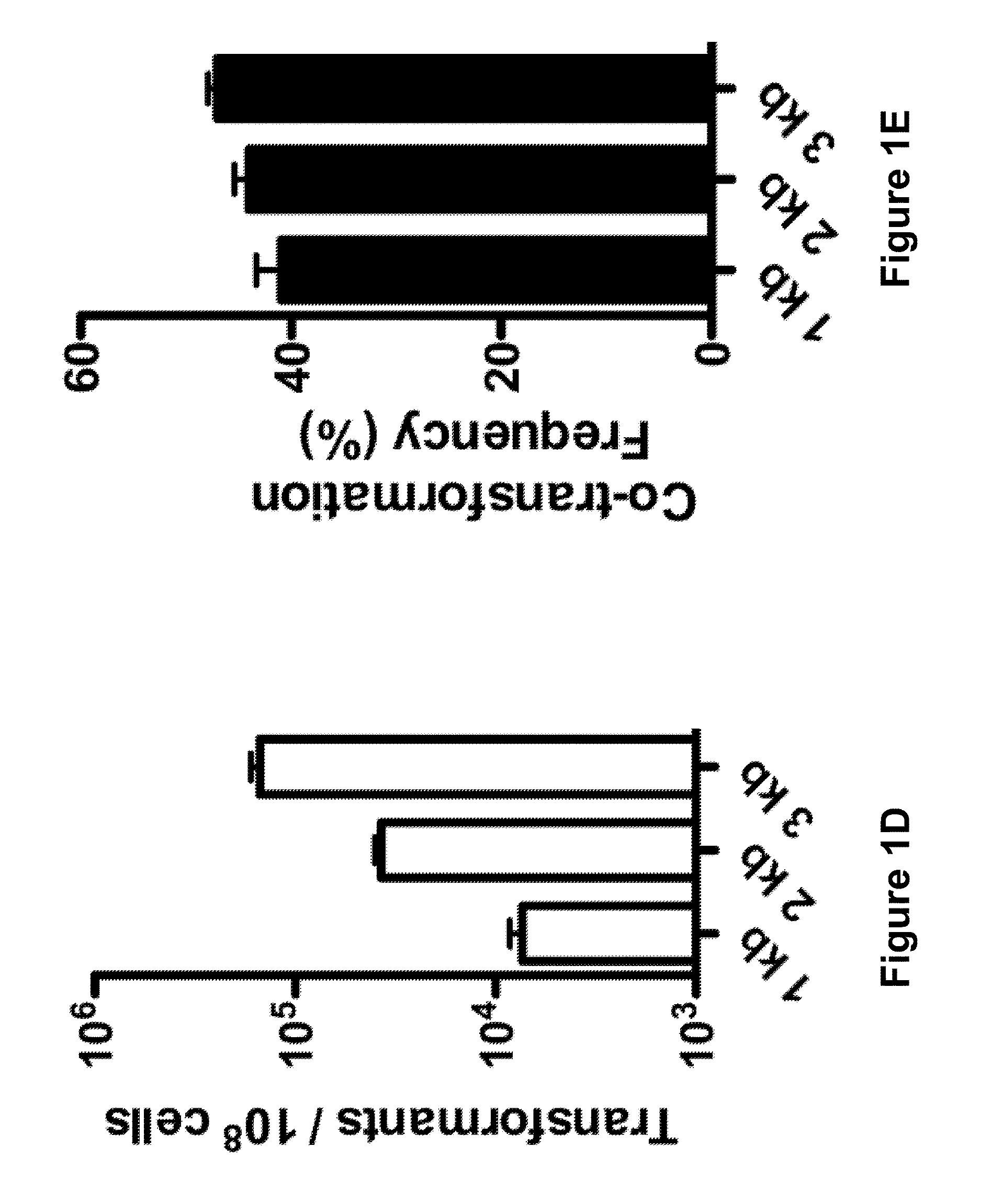Methods and apparatus for transformation of naturally competent cells
a technology of cells and methods, applied in the field of methods and apparatus for transformation of naturally competent cells, can solve the problems of limited number of tools for multiplexed genome editing, method is not easily adapted to non-model microorganisms, and the number of tools is limited
- Summary
- Abstract
- Description
- Claims
- Application Information
AI Technical Summary
Benefits of technology
Problems solved by technology
Method used
Image
Examples
example 1
Optimization of Natural Co-Transformation
[0108]As a first step, the co-transformation of two unlinked markers in V. cholerae was optimized, where one marker was selected and screened for integration of the other. A PCR (polymerase chain reaction) product was used to replace a neutral gene with an antibiotic resistance (AbR) marker (selected) and a PCR product to introduce a nonsense point mutation into lacZ (unselected) (FIGS. 1A and 6A-6B).
[0109]FIG. 6A is a schematic diagram showing co-transformation and recombination of a bacterial genome with two selectable markers from PCR products. FIG. 6B is a schematic diagram showing the recombination of a bacterial genome with one selectable marker from a PCR product and co-transformation of a plasmid carrying the selectable marker for kanamycin resistance. FIG. 6C is a graph showing the congression or random uptake of VC1807 kanamycin resistance gene in a PCR product and plasmid kanamycin resistance gene. FIG. 6D is a graph showing the tr...
example 2
Assessing Bias During Natural Co-Transformation
[0111]Results of co-transformation experiments show natural co-transformation can be used for unbiased directed evolution at a single genetic locus. Co-transformation experiments with PCR products were performed that had either 6 (N6) or 30 (N30) nucleotides randomized in the lacZ gene. To increase the complexity of mutations at the lacZ locus, multiple cycles of co-transformation were performed with the N6 and N30 unselected products by using selected products that alter the antibiotic resistance marker at the neutral locus at each cycle (FIGS. 2A and 2B). Based on deep sequencing of the input PCR product and output transformant pools, no increase in co-transformation frequency was found for sequences closer to the WT for either the N6 or N30 samples (FIGS. 2C and 2D). Furthermore, a significant correlation was found between the abundance of N6 mers in the input PCR pool to the output transformant pool, further supporting that there wa...
example 3
Multiplexed Genome Editing by Natural Transformation (MuGENT) Optimizes Natural Transformation in V. cholerae
[0112]Editing genomes in multiplex in the absence of selection can be used for “accelerated evolution” to optimize metabolic pathways and phenotypes. Thus, natural co-transformation was assessed if it can be used for multiplex genome editing. Since genome edits do not require selection, output transformants can have any number of edits, and using multiple cycles of co-transformation, the complexity of gene edits were increased in the final transformant pool (FIG. 3A).
[0113]As a proof-of-concept, the phenotype of natural transformation in V. cholerae was optimized, as many of the genes involved in natural transformation and their regulation are well characterized. In this approach, the genetic loci that would impact distinct steps of natural transformation were targeted, including uptake of transforming DNA (tDNA) into the periplasm (tfoX), transport across the inner membrane...
PUM
| Property | Measurement | Unit |
|---|---|---|
| Digital information | aaaaa | aaaaa |
| Length | aaaaa | aaaaa |
| Electrical resistance | aaaaa | aaaaa |
Abstract
Description
Claims
Application Information
 Login to View More
Login to View More - R&D
- Intellectual Property
- Life Sciences
- Materials
- Tech Scout
- Unparalleled Data Quality
- Higher Quality Content
- 60% Fewer Hallucinations
Browse by: Latest US Patents, China's latest patents, Technical Efficacy Thesaurus, Application Domain, Technology Topic, Popular Technical Reports.
© 2025 PatSnap. All rights reserved.Legal|Privacy policy|Modern Slavery Act Transparency Statement|Sitemap|About US| Contact US: help@patsnap.com



